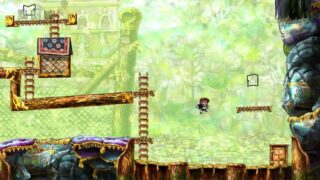
Braid is Jonathan Blow’s pride and glory, being an independently developed game that just so happened to catch everyone’s attention. With the game having been released on Xbox LIVE Arcade for over a year, it’s PlayStation Network’s turn to have a crack at the challenging puzzles Braid has to offer. They’re challenging, all right.
Braid is a puzzle game, to say the least. During the second world (it starts at two for some reason), Braid may give off the impression that it’s a platformer but as you play through the game’s six worlds, you’ll realize it’s not a platformer, but a puzzler in disguise.
The story behind Braid is pretty clichéd up to a certain point. It’s alright though, as the Super Mario Bros. references seen in the game will give you a chuckle or two as you play. The protagonist Tim has made a mistake that has caused a princess to be kidnapped and now he must save her. To do this, Tim must wander through beautiful dream-like worlds and collect puzzle pieces in order to fill in the table puzzle at the end of each world. The beginning of each world contains a series of books that tell the story of the game through text. Although, as you play through Braid you may be in for something surprising story-wise.
At first, I figured Braid was a cool little concept allowing you to reverse time; but that’s already been done. That is until I moved on to world three where time proof objects came into play, then world four where walking forward moves time and walking back reverses time. Each level has its own unique method of time manipulation. World five introduces a shadow figure of the main character Tim, and world six a ring that slows down time in a limited area. All these elements come into play when figuring out how to solve Braid‘s complex puzzles.

Since each of Braid‘s world has its own unique manipulation of time, it ensures the player that not one world is the same and that they’re not getting by easy. Braid‘s challenges will mess with you; it’s playing hardball. The first world is simple enough, but as you get deeper into the game, you’ll find it confusing as hell to manipulate time the way you want when regular time will only move when you take a step forward.
No matter what world you’re playing in Braid (besides the last), you’ll be collecting puzzle pieces. Figuring out how to get them is where the puzzle comes in, which is what Tim’s time abilities are for. After collecting said pieces, Tim will have to solve a regular table-based puzzle on his painting boards in his city apartment.
Braid‘s difficulty level always remains the same. There’s six worlds and if you play through without cheating (don’t use a guide, unless it’s official), the game will last you quite some time. My run-through took me around eight hours without knowledge of how to solve any of the puzzles presented in Braid. Now it’s possible to run through the game in a matter of ten minutes, since you can technically run through any world without collecting puzzle pieces; each level in a world is very short distance-wise. You wouldn’t complete the game, though, since the whole point is collecting those puzzle pieces and solving the table-based puzzle at the end.
The most noticeable thing about Braid at first sight is its unique visual style. The game’s creator, Jonathan Blow, used watercolors to create his game and the result is one visually stunning puzzler. Everything moves so elegantly and the colors blend in so well with the world. Even Tim’s character design, while so simple, is most applaudable; he’s an unlikely hero, just as Mario the plumber would be, except this time in a suit and tie.
Braid is a challenging puzzler, and it’s great to see so much work and dedication, resulting in magnificent gameplay, coming from an independent developer. Both Xbox LIVE Arcade and PlayStation Network game developers should take note of Blow’s work, as it really shows the outcome when hard work is put into a game. Besides being visually stunning, Braid will keep you occupied for hours with its brain-aching puzzles. Once you’re done that, there’s some replayability value with Braid‘s speed runs, if you’re really up to it. For only $15, I’d say Braid is very-well worth it.